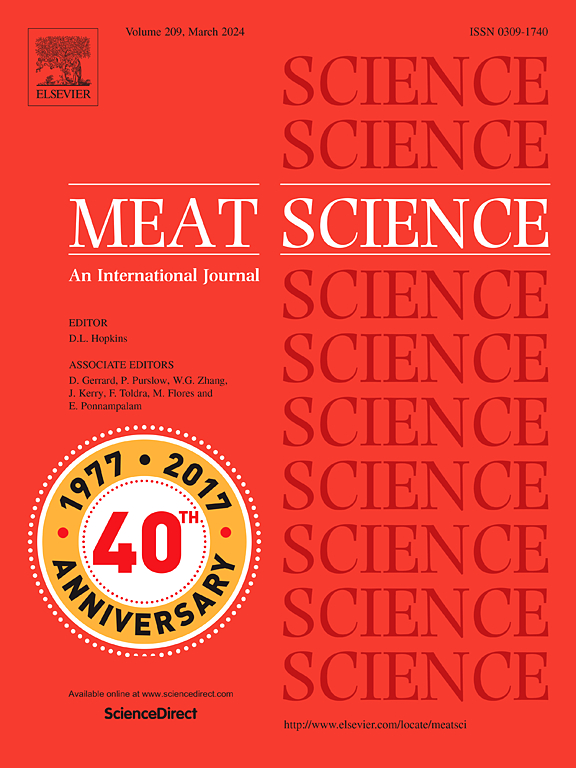How does feeding strategy affect the aromatic volatile compounds profile and sensory properties of organic fresh pork?
IF 6.1
1区 农林科学
Q1 Agricultural and Biological Sciences
引用次数: 0
Abstract
This study aimed to evaluate two feeding strategies on pork quality in organic farming using 77 non-castrated male pigs (Piétrain × Large White) reared in two batches, each including two groups. Male littermates were allocated to either a Control group (C, n = 37), fed following the organic specifications, or to a group receiving an organic test feed mainly based on French raw materials and containing more fibre and omega-3 fatty acids (Bio+, n = 40). Within batch, each group was reared in one pen from the same building on deep straw bedding with free outdoor access, with ad libitum feeding from around 33 kg until slaughter at around 128 kg of live weight. Loin meat samples were analysed by a trained sensory panel and by SPME-GC–MS to identify the main volatile compounds. Meat from Bio+ pigs showed a significantly more intense red colour (P < 0.01), but lower aromatic persistency (P < 0.05) and tended to be less tender (P = 0.08) than meat from C pigs. None of the samples were qualified as boar tainted. A total of 27 volatile compounds were quantified, with more compounds present in Bio+ pigs, probably due to the greater diversity of raw ingredients in the feeds. The multi-dimensional analyses enabled to observe relationships between volatile compounds and sensory traits but did not differentiate the two feeding strategies. Bio+ feeding strategy compared to C influenced some organoleptic characteristics (red colour of raw meat, aromatic persistency) without modifying the texture, odour and flavour of organic cooked pork.
饲养策略如何影响有机新鲜猪肉的芳香挥发性化合物特征和感官特性?
本试验以两批77头未阉割的皮氏×大白猪为试验材料,每批分为两组,研究两种饲养策略对有机养殖中猪肉品质的影响。雄性窝鼠被分配到对照组(C, n = 37),按照有机规格喂养,或接受主要以法国原料为基础,含有更多纤维和omega-3脂肪酸的有机试验饲料组(Bio+, n = 40)。在同一批次内,每组在同一栋楼的一个围栏内饲养,在有自由户外通道的深秸秆床上饲养,从33公斤左右开始自由饲养,直到活重128公斤左右屠宰。腰肉样品通过训练有素的感官面板和SPME-GC-MS进行分析,以确定主要挥发性化合物。Bio+猪的肉显示出明显更强烈的红色(P <;0.01),但芳香持久性较低(P <;0.05),且肉质较C猪差(P = 0.08)。没有一个样品被野猪污染。共有27种挥发性化合物被量化,在Bio+猪中存在更多的化合物,可能是由于饲料中原料成分的多样性更大。多维度分析可以观察到挥发性化合物与感官性状之间的关系,但不能区分两种摄食策略。与C相比,Bio+喂养策略影响了有机熟肉的一些感官特征(生肉的红色、芳香的持久性),但没有改变有机熟肉的质地、气味和风味。
本文章由计算机程序翻译,如有差异,请以英文原文为准。
求助全文
约1分钟内获得全文
求助全文
来源期刊

Meat Science
工程技术-食品科技
CiteScore
12.60
自引率
9.90%
发文量
282
审稿时长
60 days
期刊介绍:
The aim of Meat Science is to serve as a suitable platform for the dissemination of interdisciplinary and international knowledge on all factors influencing the properties of meat. While the journal primarily focuses on the flesh of mammals, contributions related to poultry will be considered if they enhance the overall understanding of the relationship between muscle nature and meat quality post mortem. Additionally, papers on large birds (e.g., emus, ostriches) as well as wild-captured mammals and crocodiles will be welcomed.
 求助内容:
求助内容: 应助结果提醒方式:
应助结果提醒方式:


